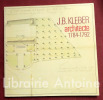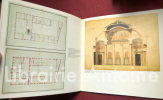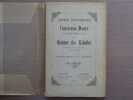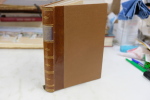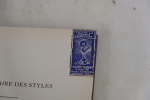-
Type
Any type (2)
Art print (7)
Book (31372)
Disk (1)
Drawings (7)
Engraving (9)
Magazine (125)
Old papers (1)
Photographs (14)
Posters (4)
-
Latest
Last 24h (8)
Last 3 days (38)
Last month (455)
Last week (41)
-
Language
Dutch (1)
English (52)
French (31445)
German (6)
Italian (18)
Portuguese (9)
Spanish (11)
-
Century
16th (15)
17th (56)
18th (219)
19th (1579)
20th (9530)
21st (1699)
-
Countries
Belgium (9489)
Brazil (7)
Canada (108)
China (1)
Côte d'Ivoire (66)
Denmark (218)
France (18541)
Germany (1)
Greece (1)
Italy (37)
Switzerland (3073)
-
Syndicate
ALAC (99)
CLAM (41)
CLAQ (94)
CNE (3)
ILAB (10920)
NVVA (1171)
SLACES (1171)
SLAM (8371)
SNCAO (9)
DUURZAME STEDENBOUW / SUSTAINABLE URBAN DESIGN : PERSPECTIEVEN EN VOORBEELDEN / PERSPECTIVES AND EXAMPLES
, Ronde Tafel, SU De, 2009 Hardcover, 176 pag. ENG / NL, 315 x 245 mm, in goede staat / in good condition, ill. in colour. ISBN 9789075271331.
Duurzame stedenbouw wordt steeds meer de drager van duurzame ruimtelijke ontwikkeling. Het boek Sustainable Urban Design. The next step brengt de actuele discussies, kennisontwikkeling en inzichten onder de aandacht en geeft nieuwe en geactualiseerde voorbeelden van geslaagde projecten. Sustainable Urban Design. The next step is een compleet herziene uitgave van Duurzame stedenbouw, perspectieven en voorbeelden, dat in 2005 verscheen. Met tekstbijdragen van: Teksten Femke Adriaens, Elma van Beek, Michiel Brouwer, Bert Bukman, Joost van den Dool, Martin Dubbeling, Jos Jonkhof, Steven Kamerling, Olga van der Linden, Karin Mak, Antony Marcelis, Micha l Meijer, Joop Nicolai, Corn van Overveld, Rob Rhemrev, Eginhard Rot, Wouter Schik, Jos Verbakel, Jeroen de Vries
Old Saint Louis Homes 1764-1865 - The Story they Tell - Photographs and Texts by Elinor Martineau Coyle (Copy signed by Author - Missouri - St. Louis)
The Folkestone Press, Saint Louis Malicorne sur Sarthe, 72, Pays de la Loire, France 1979 Book condition, Etat : Bon hardcover, under editor's black dust-jacket, illustrated by a colour photography of a house In-4 1 vol. - 176 pages
numerous black and white photographies, few of them full pages, inside and outside, a map on the end-paper 7th edition, 1979 "Contents, Chapitres : Saint-Louis (en anglais Saint Louis, souvent abrégé en St. Louis) est une ville indépendante dans le Missouri aux États-Unis, située à environ 470 kilomètres au sud-ouest de Chicago, la ville compte 319 294 habitants et Grand Saint-Louis qui est l'agglomération principale de la plus grande zone urbaine du Missouri et la 16e des États-Unis compte 2 879 934 habitants en 2008 (source US census bureau). La ville fut fondée en 1764 juste au sud du confluent des rivières du Missouri et du Mississippi par les commerçants et colons français Pierre Laclède et René Auguste Chouteau. La ville comme le futur État du Missouri devinrent un territoire de l'Empire espagnol après que les Français furent défaits durant la guerre de Sept Ans. En 1800, le territoire fut secrètement rendu à la France, que son dirigeant, Napoléon Bonaparte, revendit aux États-Unis en 1803. Surnommée la « Gateway to the West » pour son rôle dans l'expansion vers l'ouest des États-Unis, la ville donna en 1965 son petit nom à une nouvelle construction faisant partie du Jefferson National Expansion Memorial, la Gateway Arch ; l'arche est devenue l'icône de Saint-Louis. Autrefois 4e plus grande ville des États-Unis, Saint-Louis a vu sa population tomber à la 52e place. Au plus haut de sa densité, Saint-Louis accueillit l'Exposition universelle de 1904 et les Jeux olympiques d'été de 1904. Au XIXe siècle, l'immigration provenant d'Italie, d'Allemagne, de Bohême, et d'Irlande inonda Saint-Louis, colorant la cuisine et l'architecture de la ville. Beaucoup d'Afro-Américains se dirigèrent au nord de la ville durant la Grande Migration. (source : Wikipedia)" minor wear on the original dust-jacket, which remains clean and near fine, inside is fine, no markings, the book is signed by Elinor Martineau Coyle on the first page
musicalit des images au Moyen ge. Instruments, voix et corps sonores dans les manuscrits enlumin s (XIIIe-XIVe si cles)
, Brepols, 2021 Paperback, 434 pages, Size:190 x 290 mm, Illustrations:142 col., Language: French. ISBN 9782503588551.
Summary Par les images, la musique est figur e de fa on inventive et tonnante dans les manuscrits enlumin s entre le XIIIe et le XIVe si cle, principalement en France et en Angleterre. C'est cette capacit d'invention des enlumineurs rendre visible ce qui est invisible, savoir les sons des instruments et les voix des chanteurs, qui retient l'attention. La d marche consiste se fonder sur les cadres g n raux de formation et de pens e des lettr s de l' poque : les arts lib raux et la th ologie. partir de cette culture savante commune, ce livre cherche comprendre les diff rents proc d s visuels labor s par les concepteurs d'images pour faire voir et entendre la musique sur le support mat riel et culturel particulier du manuscrit. Dans la soci t m di vale, le verbe et l'image sont aux fondements th ologiques et anthropologiques du corps et de l' me. Cette tude postule alors que les images du roi David, des jongleurs, des fous, des b tes, des hybrides, participent d'une double repr sentation culturelle et morale : celle du statut social des gens de savoir , initi s la musica, concepteurs des livres et des images l'usage des clercs, la cs et/ou nobles cultiv s ; celle du but ultime des savoirs des lettr s, et donc des livres enlumin s : la conversion des m?urs par la discipline des corps en vue du salut des mes. TABLE OF CONTENTS Pr face - Jean-Claude Schmitt Introduction 1 re partie. Les livres d votionnels : savoirs et pratiques sociales entre clercs et nobles 1. Statuts sociaux et circulation des livres : clercs et nobles la cs 2. Savoirs : arts lib raux et images de la musique 3. Figures rh toriques et motifs musiciens pour les sens et la m moire 2e partie. David, mod le de la musique dans les images 1. Les instruments et les gestes de David : harpe, orgue et cloches 2. Jouer d'un instrument : gestes, mouvements et corps sonores 3. Le son et l'oreille : objectivation, zoomorphisme et anatomies 3e partie. Pr dication, images et musicalit s : les passions des corps 1. Corps, gestes et voix des ma tres de la parole 2. Chants, paroles et voix : chantres et animaux 3. difier et convertir : des passions la R demption Conclusion Liste des manuscrits enlumin s Bibliographie Index
Musique, sexe et d votion. Les images marginales des livres d votionnels (XIIIe-XIVe si cles)
, Brepols, 2023 Paperback, 108 pages, Size:110 x 180 mm, Illustrations:25 b/w, Language: French. ISBN 9782503605838.
Summary Point de pudibonderie, ni de puritanisme hypocrite dans les enluminures des livres de d votion m di vaux. L'association des instruments de musique, de l'obsc nit et des m taphores homo- et h t rosexuelles caract rise les d cors des marginalia de la majorit des manuscrits d votionnels des XIIIe et XIVe si cles. Les dr leries musiciennes et rotiques en sont des ornements communs et r pandus dans les psautiers et les livres d'heures des la cs et des clercs. Ceux-ci en sont d'ailleurs les concepteurs, lettr s pourtant garants de la morale sexuelle. De nos jours, ce paradoxe tonne d'autant plus que ces livres de pri res sont l'usage des femmes de l'aristocratie, qu'elles soient fianc es, pouses, amantes, veuves, abbesses ou moniales. Il contraste certainement avec l'id e que l'on peut se faire des cultures savantes et des pratiques religieuses du Moyen ge. Or, c'est sous l'autorit de l'Eglise que images et musiques des corps interrogent les sexualit s et le genre, la norme et la transgression,et par-l , le corps et l' me et la place de l'humain dans le monde cr ; A contre-courant, peut- tre, des id es pr con ues sur le Moyen ge, leur audace invite r fl chir sur les rapports aux images et au religieux dans la soci t m di vale, et par ricochet dans celle d'aujourd'hui.
Sermons Dolbeau 1-10
, Brepols, 2020 Hardback, 552 pages, Size:115 x 165 mm, Languages: Latin, French. ISBN 9782851213099.
Summary In 1990, in a 15th century manuscript kept in the Stadtbibliothek in Mainz, Fran ois Dolbeau recognized a series of authentic Augustine sermons, some completely unknown until then, others known in brief versions. Five years of work were then necessary for their discoverer to establish the editio princeps, which was published in 1996 in the Collection des tudes Augustiniennes : Vingt-six sermons au peuple d'Afrique. This first volume of the Sermones Dolbeau is devoted to Sermons 1 to 10. A motivated team of specialists offers here a revised Latin text, an unpublished French translation, an introduction specific to each sermon as well as numerous footnotes and additional notes. En 1990, dans un manuscrit du XVe s. conserv la Stadtbibliothek de Mayence, Fran ois Dolbeau a reconnu une s rie de sermons d'Augustin authentiques, les uns totalement inconnus jusque-l , les autres connus dans des versions br ves. Cinq ans de labeur furent ensuite n cessaires leur d couvreur pour en tablir l'editio princeps, qui parut en 1996 dans la Collection des tudes Augustiniennes : Vingt-six sermons au peuple d'Afrique. Ce premier volume des Sermons Dolbeau est consacr aux Sermons 1 10. Une quipe motiv e de sp cialistes nous offre ici un texte latin r vis , une traduction fran aise in dite, une introduction propre chaque sermon ainsi que de nombreuses notes infrapaginales et notes compl mentaires.
Sermons Dolbeau 11-20
, Brepols - Institut d' tudes Augustiniennes, 2023 Hardback, 518 pages, Size:115 x 165 mm, Language(s):French, Latin. ISBN 9782851213242.
Summary In 1990, in a 15th century manuscript kept in the Stadtbibliothek in Mainz, Fran ois Dolbeau recognized a series of authentic Augustine sermons, some completely unknown until then, others known in brief versions. Five years of work were then necessary for their discoverer to establish the editio princeps, which was published in 1996 in the Collection des tudes Augustiniennes : Vingt-six sermons au peuple d'Afrique. This second volume of the Sermones Dolbeau is devoted to Sermons 11 to 20. A motivated team of specialists here offers a revised Latin text, an unpublished French translation, and an introduction specific to each sermon, as well as numerous footnotes and additional notes. En 1990, dans un manuscrit du XVe s. conserv la Stadtbibliothek de Mayence, Fran ois Dolbeau a reconnu une s rie de sermons d'Augustin authentiques, les uns totalement inconnus jusque-l , les autres connus dans des versions br ves. Cinq ans de labeur furent ensuite n cessaires leur d couvreur pour en tablir l'editio princeps, qui parut en 1996 dans la Collection des tudes Augustiniennes : Vingt-six sermons au peuple d'Afrique. Ce deuxi me volume des Sermons Dolbeau est consacr aux Sermons 11 20. Une quipe motiv e de sp cialistes nous offre ici un texte latin r vis , une traduction fran aise in dite, une introduction propre chaque sermon ainsi que de nombreuses notes infrapaginales et notes compl mentaires. TABLE OF CONTENTS Avant-propos Sermons Dolbeau 11-20 Sermon Dolbeau 11 Sermon Dolbeau 12 Sermon Dolbeau 13 Sermon Dolbeau 14 Sermon Dolbeau 15 Sermon Dolbeau 16 Sermon Dolbeau 17 Sermon Dolbeau 18 Sermon Dolbeau 19 Sermon Dolbeau 20 Notes compl mentaires 1. chos n oplatoniciens dans le Sermon Dolbeau 11 2. La parabole du fils prodigue (Ser. Dolbeau 11, 10) 3. Qu'as-tu que tu n'aies re u ? (1 Co 4, 7) (Ser. Dolbeau 11, 14) 4. La doctrine du mariage dans le Sermon Dolbeau 12 5. Les liens du Sermon Dolbeau 12 avec le De bono coniugali 6. Le corps comme v tement (Ser. Dolbeau 13, 4) 7. ve et la tentation de l' poux (Ser. Dolbeau 13, 7) 8. L'interpr tation augustinienne des tentations du Christ (Ser. Dolbeau 13, 8) 9. Maior misericordia (Ser. Dolbeau 14, 1) 10. La p nitence (Ser. Dolbeau 14, 3-5) 11. Le th me des faux martyrs distingu s par la cause (Ser. Dolbeau 15, 6-7) 12. Duritia et patientia (Ser. Dolbeau 15, 7) 13. L'arbre et ses fruits (Mt 12, 33) (Ser. Dolbeau 16) 14. Le figuier st rile (Lc 13, 6-9) (Ser. Dolbeau 16, 3) 15. Les interpr tations de Lc 12, 47-48 (Ser. Dolbeau 16, 7) 16. L'explication continue du Psaume 4 (Ser. Dolbeau 16, 11-16) 17. L'ex g se de la gu rison de la femme courb e (Ser. Dolbeau 17) 18. Les martyrs in occulto (Ser. Dolbeau 18, 7-11) 19. Le pain c leste : la th matique eucharistique (Ser. Dolbeau 19, 1. 7. 12) 20. Operemur Christum : l'incorporation au Christ (Ser. Dolbeau 19, 1. 5. 6) 21. Foi de Pierre et foi des d mons (Ser. Dolbeau 19, 2. 5) 22. Jn 6, 29 et la distinction credere Christum, credere Christo, credere in Christum (Ser. Dolbeau 19, 3-6) 23. Jamais nous n'osons dire : ?Crois en moi? (Ser. Dolbeau 19, 3) 24. Qu'il n'exige rien d'autre de moi ! : la foi et les ?uvres (Ser. Dolbeau 19, 4-5. 11-12) 25. L'explication de Ph 3, 9 : Non habens meam iustitiam, quae ex lege est (Ser. Dolbeau 19, 10-11) 26. Les fid les se tournaient-ils physiquement vers l'Orient ? (Ser. Dolbeau 19, 12) 27. Le statut des critures canoniques (Ser. Dolbeau 10, 5. 15) Index biblique Index des auteurs anciens
LE NORD. UN ART DE VIVRE ENTRE BEFFROIS ET MOULINS
La Renaissance du Livre 2001 In-4 à l’italienne, relié sous jaquette illustrée en couleurs.
Très bon état d’occasion
"Antonio Gaudi 1852-1926 (Collection ""Art et artistes, série Les Architectes"")"
A. Hatier. 1955. In-12. Broché. A relier, Couv. légèrement passée, Coiffe en tête abîmée, Papier jauni. Environ 70 pages. Nombreuses planches d'illustrations, photos en noir et blanc et en couleurs. Quelques pages désolidarisées. Couverture contrepliée, partiellement désolidarisée. Accrocs en coiffe en tête. Quelques rousseurs.. . . . Classification Dewey : 720-Architecture
"Collection ""Art et artistes, série Les Architectes"". Classification Dewey : 720-Architecture"
Palais du Rajasthan
L'architecture palatiale de l'État du Rajasthan, au nord-ouest de l'Inde, est très certainement la plus exceptionnelle de l'architecture civile indienne ; c'est sans doute la raison pour laquelle il s'agit de la région la plus visitée - et la plus aimée - des touristes français. - Format : Broché, 270 pages - Dimensions : 26,0 x 33,5 x 2,8 cm - Illustrations en couleurs - Etat très correct, légers griffements très peu discernables
Oblique n° 2, réplique.
Renens, Vie Art Cité Association 2012, 280x230mm, reliure demi-toile de l’éditeur. Tiré à 1500 exemplaire. Exemplaire à l'état de neuf.
photos couleurs et n/b, Pour un paiement via PayPal, veuillez nous en faire la demande et nous vous enverrons une facture PayPal
J. B. Kleber architecte 1784-1792
1986 In- 8 carré (h. 21 cm.) 96 pp. 12 planches broché.
Catalogue de l'exposition au Musée d'Unterlinden de Colmar consacrée à la première carrière de Jean-Baptiste Kleber comme architecte des bâtiments publics, avant une brillante carrière militaire, qu'interrompit son assassinat au Caire en 1800. Quelques annotations au crayon à papier, sinon très bon état. Libraire membre du S.L.A.M. (Syndicat national de la Librairie Ancienne et Moderne) et de la L.I.L.A. (Ligue Internationale de la Librairie Ancienne). N'hésitez pas à prendre contact par mail pour des photographies et des détails supplémentaires, pour des recherches ou des estimations de livres anciens et rares.
Mont Loon : Reflet fidèle de la montagne et des environs de Laon, de 1100 à 1300
Editions de l’Imprimerie du Courrier de l’Aisne 1972 In-4 relié 30 cm sur 21,5. 169 pages. Bon état d’occasion.
Bon état d’occasion
Notice historique sur l'ancienne Route de Charles-Emmanuel II et les Grottes des Echelles. Avec pièces justificatives et documents.
Librairie A. Perrin - Librairie A. Bolliet Chambéry - Aix-Les-Bains 1887 In-8 ( 225 X 140 mm ) de XVI-235 pages, broché sous couverture imprimée. EDITION ORIGINALE. Rousseurs passim, bon exemplaire, non coupé.Extrait de la table: Etat des communications entre la vallée des Echelles et celles de Couz, à l'époque romaine. - Construction de la route de Charles-Emmanuel II, 1re période: études préliminaires le maître auditeur Deschamps. - Construction de la route de Charles-Emmanuel II. 2e période: projets et travaux d?exécution le maître auditeur Balland. - Le monument élevé à Charles-Emmanuel II à la route des Echelles. Déboires de Balland au sujet de l'inscription commémorative qui y figure Etc, Etc.
A History of Pictures : From the Cave to the Computer Screen David Hockney & Martin Gayford -
, Abrams, 2020 Paperback, 370 pages, ENG. edition, 240 x 165 mm, NEW, richly illustrated in color / b/w. ISBN 9781419750281.
A compact edition of Hockney and Gayford?s brilliantly original book, with updated material and brand-new pieces of art Informed and energized by a lifetime of painting, drawing, and making images with cameras, David Hockney, in collaboration with art critic Martin Gayford, explores how and why pictures have been made across the millennia. Juxtaposing a rich variety of images?a still from a Disney cartoon with a Japanese woodblock print by Hiroshige, a scene from an Eisenstein film with a Velazquez paint ing?the authors cross the normal boundaries between high culture and popular entertainment, and argue that film, photography, paint ing, and drawing are deeply interconnected. Featuring a revised final chapter with some of Hockney?s latest works, this new, compact edition of A History of Pictures remains a significant contribution to the discussion of how artists represent reality. David Hockney is one of the world?s most popular painters and the author of the bestselling Secret Knowledge: Rediscovering the Lost Techniques of the Old Masters (2001). Martin Gayford is an art critic and the author of many books, including Man with a Blue Scarf: On Sitting for a Portrait by Lucian Freud (2013) and Rendez-vous with Art, with Philippe de Montebello (2014).
Rome And Jerusalem : The Clash Of Ancient Civilizations
, Penguin Books Ltd 2007, 2007 Hardcover, 656 pages, English, 240 x 165 mm, with some illustrations in b/w, in good order, . ISBN 9780713994476.
In this magisterial history of the titanic struggle between the Roman and Jewish worlds that led to the destruction of Jerusalem, Goodman examines this conflict, its causes, and its consequences with unprecedented authority and thoroughness.
Francis Bacon Retrieved Lost Words / New Writing
London, Thames & Hudson, 2025 Softcover, 232 pages, 26 x 20 cm, english text. *New . ISBN 9780500966273.
The fifth volume in the acclaimed Francis Bacon Studies series, published under the aegis of The Estate of Francis Bacon. David Sylvester's Interviews with Francis Bacon remain the most consulted writing on Bacon. In this book, the fifth volume in the acclaimed Francis Bacon Studies series, Bacon's words appear in their unredacted form for the very first time. Other essays throw light on form and accident in Bacon's work, chimera and liminal entities, the psychology of the imposter and destroyed
Francis Bacon Retrieved Lost Words / New Writing
, Thames & Hudson, 2025 Hardback, 260 x 200 mm, 100 Illustrations col.ill., 232 Pages, English ed. *new. ISBN 9780500966273.
Martin Harrison, Maria Balaska, Amanda J. Harrison, Darian Leader The fifth volume in the acclaimed Francis Bacon Studies series, published under the aegis of The Estate of Francis Bacon. David Sylvester's Interviews with Francis Bacon remain the most consulted writing on Bacon. In this book, Bacon's words appear in their unredacted form for the very first time. Other essays throw light on form and accident in Bacon's work, chimera and liminal entities, the psychology of the imposter and destroyed paintings
Complete Content Cameos.
, Brepols 2018, 2018 Hardcover.iv + 407 p., 583 col. ills, 225 x 300 mm, English, , . ISBN 9782503578965.
This catalogue of the largest collection of ancient cameos in private hands, represents forty years of collecting these historical documents in hardstone. While part of the collection was on public display at the Ashmolean Museum, Oxford (1990-2000), the whole collection has never been shown. Several recent publications have made it possible to draw more precise conclusions based on a larger sample of cameos available for comparative study. This increased number of published cameos has allowed studies of the popularity of particular subjects at certain periods, of the development of styles and techniques, and of the relative popularity of some gem materials over time. The development of digital photography has enabled gem photographers to show undreamt-of detail, allowing much closer study of tool marks and even individual artists' hands.
LA GRAMMAIRE DES STYLES. COLLECTION DE PRÉCIS SUR L'HISTOIRE DE L'ART. LE STYLE LOUIS XIII. LE STYLE LOUIS XIV. LE STYLE LOUIS XV. LE STYLE XVI. LE STYLE EMPIRE.
1929 chez Flammarion. In-8, relié, 60 pages. Nombreuses illustrations en noir et blanc. Exemplaire en bon état. Présence de quelques marques d’usage. Vignette ex-libris.
LA GRAMMAIRE DES STYLES. LA RENAISSANCE FRANCAISE.
Librairie d'Art R. Ducher. 1928. In-8. Broché. Etat d'usage, Plats abîmés, Dos abîmé, Intérieur bon état. 63 pages, 42 figures dans le texte, 12 planches hors texte avec 37 documents, tampon, manque couverture.. . . . Classification Dewey : 720-Architecture
Collection de précis sur l'histoire de l'art publiée sous la direction de Herny Martin. Classification Dewey : 720-Architecture
La grammaire des styles. La Renaissance italienne.
broché - 15,5x22 - 63 pp - 1946 - éditions FLAMMARION, Paris. Ouvrage orné de 47 figures dans le texte et de 15 planches hors texte.Collection de précis sur l'histoire de l'art, publiée sous la direction de Henry MARTIN.42ème mille.
La grammaire des styles. La Renaissance italienne.
broché - 15,5x22 - 63 pp - 1948 - éditions FLAMMARION, Paris. Ouvrage orné de 47 figures dans le texte et de 15 planches hors texte.Collection de précis sur l'histoire de l'art, publiée sous la direction de Henry MARTIN.32ème mille.
La grammaire des styles : L'art byzantin.
Couverture souple. Broché. 64 pages.
Livre. Editions Flammarion, 1946.
 Write to the booksellers
Write to the booksellers






